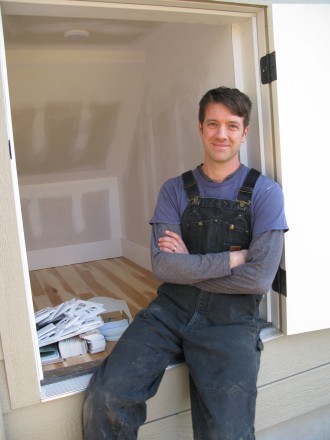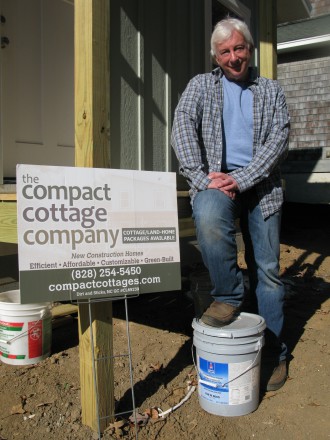Bob Swanson’s passion for tackling Asheville’s affordable housing shortage didn’t come from an epiphany. It was more like the culmination of a slow burn.
Swanson and his wife, Linda, moved to East Asheville five years ago, although he didn’t involve himself with local government right away. In 2015, the professional real estate investor decided it was time to learn more about the place in which he lived and worked. He began attending City Council meetings. What he found out alarmed him. “I didn’t know the extent of the problem,” he recalls.
At the end of 2014, the rental vacancy rate in Asheville and Buncombe County was less than 1 percent, according to a city-funded report. More than 40 percent of local renters were spending over 30 percent of their gross annual income on housing-related costs, and more than 25 percent of city and county homeowners were in the same boat.
Concerned, Swanson began attending meetings of Asheville’s all-volunteer Affordable Housing Advisory Committee. “As a real estate investor, I believe I have an ethical and moral responsibility to help solve this,” he explains, adding, “I see myself as a liaison between real estate investors and the city.”
With his soft-spoken manner and decades of real estate experience, Swanson seems well-suited to serve as an ambassador between his colleagues and Asheville housing staff. So he decided to pitch the idea of addressing the affordable housing crisis to the Carolinas Real Estate Investors Association, a local nonprofit he’s involved with. Swanson serves on the board and is the organization’s director of member services. Some CREIA members felt that moral or ethical decisions are best left to individuals, but the board agreed to host an educational event for members.
“Small Is Big: New Trends in Affordable Housing,” a panel discussion moderated by Swanson, was held Nov. 14 at the Hilton Asheville Biltmore Park. The free event, which was open to the general public, focused on building smaller homes (less than 1,000 square feet), which Swanson believes will be a key to alleviating the crisis. In 2015, the median size of a new single-family home in the U.S. was 2,467 square feet, the largest figure on record, census data show.
Going small makes sense, says Jeff Staudinger, the city’s assistant director of community and economic development, because it reasserts the importance of appropriate housing for singles, lower-income people and others who don’t fit the traditional assumptions. Building smaller homes of various sorts and incorporating them “into existing city environments,” he maintains, can help increase both density and supply. “I’m hoping something really positive comes out of the CREIA ideas,” says Staudinger.
Backyard builders
Three of the four speakers at the November panel discussion own companies that build smaller homes.
Teal Brown told an audience of roughly 150 about his company, Wishbone Tiny Homes, which builds residences of up to 800 square feet. Although there’s no universally accepted standard, tiny homes are often defined as being no more than 400 square feet and set on either a foundation or a trailer. They can occupy their own lot or be placed in someone’s yard.

A June 2015 Asheville zoning change allows homeowners in the city to build “accessory dwelling units” adjacent to the existing residence and up to 70 percent of its size. In other words, not all ADUs qualify as tiny — or even smaller — homes. In either case, said Brown, the owners have the option of renting the smaller unit. And if they’re looking to downsize, they can choose to move into it and rent out the primary home.
Asheville has long allowed secondary residential structures, and in 1997 general ADU guidelines were added to the Universal Development Ordinance, but that didn’t prevent the critical shortage of affordable housing that the city is facing today.
Making it pay
The prospect of “becoming an ADU-type of investor” is what drew West Asheville resident Deborah Busch to the panel discussion.
“I have a nice size lot in West Asheville — a high-demand market,” said Busch, who runs an online retail business and is not a CREIA member. “Who doesn’t love the idea of an income-producing property?”
The panelists, she said, showed her ways she could get a better return on such an investment while also “helping a little bit with the affordable housing shortage.”
Fellow West Asheville resident Oscar Molina also liked what he heard from the panelists. A photographer and server who used to belong to CREIA and is considering rejoining, Molina said he’s looking to buy his first investment property within the next six months.
Besides Brown’s talk on tiny homes and ADUs, Molina was struck by Allan Clark’s presentation on designing and manufacturing houses made out of recycled shipping containers, calling the speaker’s ideas “amazing.” Clark’s Mars Hill-based company, Iron Castles, is so new that as of mid-November he was still negotiating with his first customer.
Shipping containers have been successfully turned into houses in England, the Netherlands and Denmark, noted Clark. The Asheville resident, whose background is in landscape architecture, architecture and civil engineering, said, “I’m offering people a way to live off the grid — that’s right up my alley.” Outfitted with solar panels, these self-sufficient container homes would be perfect for people on fixed incomes and recent college graduates with student loans, said Clark. “This is my way of fighting global warming and creating ad hoc communities.”
Finding the funding
Investing in alternative living arrangements — whether they’re converted shipping containers, tiny homes, ADUs or simply more compact dwellings built on less land — is not only savvy, it’s socially responsible, Swanson and some other CREIA members maintain. But there’s at least one major hitch: So far, only people with money to spare have been able to capitalize on the city’s zoning change to build an ADU.
“Federal underwriting guidelines don’t allow people to use projected money generated from the accessory dwelling unit as part of their income when they apply for a loan to build one,” says Barry Bialik. His company, Compact Cottages, offers five home models that typically cost less than $200,000. A panelist at the CREIA event, Bialik also chairs the city’s Affordable Housing Advisory Committee.

As of October, he notes, only 16 ADUs had been built in Asheville this year. Twelve were funded with cash, he says; the other four by home equity lines of credit or refinancing the existing mortgage. The city has no loan program for folks wanting to build an ADU.
HomeTrust Bank does offer temporary financing for ADUs to qualifying borrowers who already live on the land, loan officer Jill Dotson explains, but, “It is similar to a construction mortgage.” Construction loans are typically harder to get, last no more than a year and carry a higher, variable interest rate.
People with good credit and enough equity in their home can simply take out a credit line to finance the ADU, but for many people, that’s not an option.
Meanwhile, the city is considering changes to its Housing Trust Fund rules that would encourage smaller-scale projects, converted shipping containers and tiny homes, Staudinger explains. In addition, the maximum loan amount would double, to $1 million. The trust fund makes low-interest loans to projects meeting affordability guidelines. At press time, City Council was slated to vote on the changes at its Dec. 13 meeting.
No silver bullet
Not everyone believes that building smaller homes can significantly impact the area’s affordable housing crisis, however. Some skeptics say the market for those kinds of residences simply isn’t big enough to make much of a dent in the shortage. Others question whether products such as tiny homes could be profitably produced in sufficient quantities.
“ADUs can be a piece,” says Samuel Gunter, director of policy and advocacy at the North Carolina Housing Coalition in Raleigh. His organization, though, “is not doing any major work on ADUs at the state or federal level. I don’t think that’s where we’re going to find the most bang for our buck. They’re not going to be the silver bullet that some say they’re going to be.”
Gunter cites the experience of Denver, which has allowed accessory dwelling units as an affordable housing solution since 2010. “Denver and Asheville are somewhat similar: Both are mountain cities with large tourism sectors and geographical limitations on buildable land.” Officials there, he says, “poured a lot of energy into their plan; they charted a path and came up with an incentive package.”
As of September, however, only a few dozen such units have been permitted in this city of about 683,000 people.
Chris Estes, president and CEO of the National Housing Conference, agrees. Advocates of tiny homes, ADUs and shipping-container residences may promise more than they can deliver, he believes. The Washington, D.C.-based nonprofit seeks to “ensure safe, decent and affordable housing for all in America,” according to its website.
Similar approaches tried in San Francisco, New York and D.C. did not enhance affordability, says Estes, who was executive director of the North Carolina Housing Coalition for nine years before accepting his current position.
As land values in those cities went up, he explains, so did rents. “Those types of housing don’t stay affordable as communities grow, especially when young people will pay a lot to live in desirable places.”
The common good
But those arguments haven’t deterred CREIA board member Nancy Duggan, who says she’s been building smaller, more affordable homes for decades. “There’s definitely money to be made,” she reports. “I’ve been providing small-scale affordable housing for 27 years and have made plenty of money.” All of those projects, she notes, were workforce housing.
And even if the smaller-home approach can’t single-handedly solve Asheville’s housing crisis, it’s still expanding the supply while also helping some folks who are getting squeezed out by the area’s rising real estate prices.
“If you’re earning $35,000 a year and can’t afford to buy a house, that’s deplorable,” she declares. Duggan says she’s built about 30 houses in Buncombe County, and “most cost less than $200,000.”
Duggan is not alone, notes Bialik. Throughout the U.S., there are communities of investors who are interested in solid, stable financial returns — and, more importantly, social returns. Increasingly, Bialik maintains, today’s investors want to feel their money is contributing to the common good.
“What’s better? Making a 10 to 15 percent return on an affordable housing investment or the same amount in oil stocks?” he asks. “It’s not just about the money anymore.”






While I certainly hope something can be done to create genuinely affordable home ownership opportunities in Asheville, Greenville, SC is such a buyers market that I could not ignore it and bought there. Amazingly, Greenville, SC has a more diverse population than Asheville, higher wages, and home prices which are about half of what they are in Asheville. I have lived in many places between my home in NY and southern Florida, and Greenville is more affordable, has no winter season, and is free from the hyperbolic marketing to tourists that plagues Asheville. My Greenville neighborhood is clean, safe, multi-racial, multi-ethnic, and has mountain views. A 3 bedroom 2 bath house can be purchased for less than $150K in Greenville. If you look at the staff of the Asheville Chamber of Commerce, you will notice virtually no minority staff members in a city with a 15% African-American population. This tells me that Asheville is primarily about the promoting of comfort to the wealthy white privilige folks, with everyone else just being a cog in that machine. Just understand that the playing field is not level by design in Asheville.
Good info shared until you got to the race-baiting part. Do you suggest that people who may not be qualified for particular jobs be hired because their skin is a different color than white? Does that make sense to you?
And your numbers aren’t accurate. Asheville city is 13% African-American and Buncombe County is less than 6.5%. We also have residents of other colors and ethnic backgrounds however the numbers are smaller.
The statistics regarding the percentage of the African American population vary depending upon the source used. I have seen percentages as high as 17% for example, so I just chose 15%. The socioligical point is that if the primary business organization is not even closely repesent the ethnic composition of the city, then that is indicative of a problem. More egalitarian cities in the eastern US have much more diverse business organizations for example. If Asheville does not want to be egalitarian, they should just admit up front that it’s all just about money. There are plenty of native white people who have also been driven out of Asheville because of rising home prices and rents as well. Money will probably win out, resulting in Asheville just being completely unaffordable for most wage earners. The city and county governments are betting that tens of thousands of retirees will move here, and if they are wrong, prices may not continue to rise. There are plenty of local developers who lost their entire businesses during 2006-2008. It could happen again.
I don’t know why anyone would use other than the US Census: http://www.census.gov/quickfacts/table/PST045215/37021
Using Asheville city stats isn’t indicative of much, it’s a small town. Many people live in surrounding areas and drive to other areas (or downtown) to work. The population numbers are as I state above but are not relevant to this.
Are you an academic? I ask because this sentence makes no sense and anyone from the business arena wouldn’t utter it, “business organization is not even closely represent the ethnic composition of the city, then that is indicative of a problem.” — No, Rob, it doesn’t represent a problem but rather a lack of your understanding of this metro, of the function of business and that there are vast swathes and pockets of the USA that are not “diverse” and it’s not a problem. You are evidencing a misguided desire for forced social engineering. Please, give it a rest, it is not helpful. Things are fine here and moving along in many directions continually.
LOL, Greenville wants manufacturing jobs and modern infrastructure. Here, Smith gets in the way of upgrading the Smokey Park bridge and I-26 corridor for close to 20 years now. He was instrumental in pushing out Gerber and Ball. The elitist morons who live in Asheville part time or retire here don’t want change. Or they assume that tech will move here and not disrupt their lives. But the anemic economy for the majority and the low payed underclass that can’t afford to purchase housing means that those jobs are going south. BMW starts out at 16 and hour with a 2000 sign on bonus. GE Turbine systems is starting out at 30 an hour. That pay is never ever going to happen here in this crap town. They don’t want those jobs here. That might shake up the establishment after all. So let Asheville be nothing but a gloryfied tourist trap that fleeces the residents for the impact that the tourist industry causes. And allow those industries to literally make millions without putting any of it back into the area. In terms of taxation, jobs, or improvements.
“My Greenville neighborhood is clean, safe, multi-racial, multi-ethnic, and has mountain views.”
If you have strong enough binoculars.
Halfbacks gonna halfback.
Greenville housing prices are lower than Asheville’s because, well because you’re in Greenville. Oh, and Greenville is hotter than hell 6 months per year, if you like that.
Without significant and active gay and transgender communities, Greenville CANNOT POSSIBLY have “a more diverse population than Asheville.” and unlike race, this kind of diversity sells houses. http://www.amazingasheville.net/lgbt-asheville.html , http://williamsinstitute.law.ucla.edu/uncategorized/south-carolina/ , http://williamsinstitute.law.ucla.edu/uncategorized/north-carolina/
First, let’s remember that investors invest to make money, and not to lose it, or break even. Now that this is cleared up, what was the question, again?
I believe Gordon Smith can answer this question.
Yes, Greenville SC is attracting Asheville investors because of the problems developing here. There are reasons WHY housing is so lacking here, right City Council and Housing Authority ? ? ? AVL is simply the most pathetically run ‘city’ imaginable. Do ANY of you people realize the kind of turnover occurring in the city development services dept. ? ? ? It’s nothing but a revolving door with files being lost and people lying to you all day long there…total MESS. Took my guy over one year to get 3 lots approved for a driveway ! ! AVL is total BS all the way around and FULL of EVIL people running it!
How are “federal underwriting guidelines” even relevant when the vast majority of lenders are private and can loan to whoever they want??? To be relevant, they would have to be not “guidelines” but oppressive regulations!